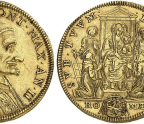THE AFTERLIFE OF COINS


Despite the cynicism adapted coins receive the second lives that some coins have had are worth study in themselves and the resulting objects, items of currency transformed into things with a different use, can sometimes be more collectable than unaltered coins would be.
Perhaps the most obvious way to adapt a coin is to make it into a pendant either by attaching a suspension loop to the edge of the coin or by the simpler expedient of drilling a hole through it. This latter practice has certainly gone on since the days of the Roman Empire as attested by coins found in hoards of that date with a neatly drilled hole. The practice has continued to the present day, coins of all dates and periods being found treated in this way. Sometimes silver coins are gilded (figure 1). The threading of a cord through a holed coin to make a pendant, or perhaps simply to keep the coin safe, is an easy thing to accomplish.
Many pierced Roman coins are
You’re reading a preview, subscribe to read more.
Start your free 30 days





